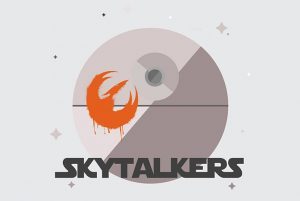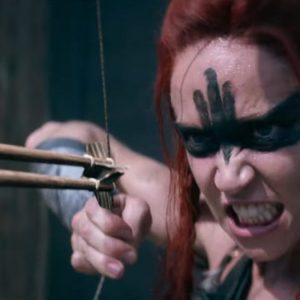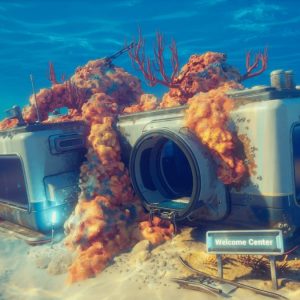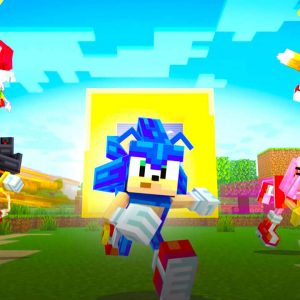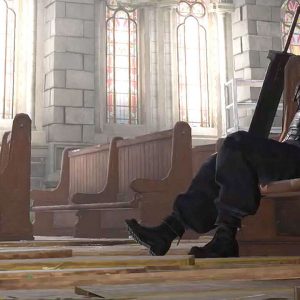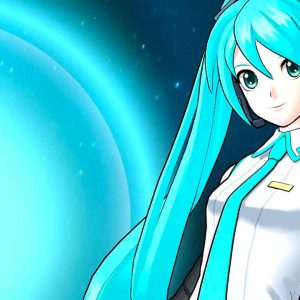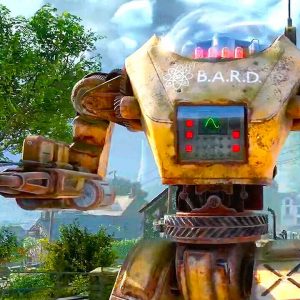For years, many assumed Skull and Bones was a ghost ship; the Ubisoft pirate game that would never make it to harbour. Having suffered six public delays, it is one of the most frequently postponed games of all time. The near total silence that surrounded it year after year convinced people that it was either permanently anchored at the port of development hell, or that it had already sunk to the bottom of the ocean. But within the halls of Ubisoft Singapore, hundreds of developers were navigating a storm of design problems in hunt of their white whale.
Now, almost seven years since it was first revealed, Skull and Bones is ready to set sail. But this final version is very different to the game we first saw in 2017. Across its development journey the naval battler has changed forms multiple times, with its final design emerging from a major reboot that prolonged development and left several prototypes shipwrecked. This is the inside story of Skull and Bones’ many delays, and the challenges that caused them.
In Skull and Bones, the Indian Ocean is your playground. You’re free to explore its open world and hunt down the food and materials you need to survive in the golden age of piracy. You can take on contracts that build your infamy and push you towards the ultimate goal of becoming a fearsome pirate kingpin. Its story is minimalist, promoting your own adventures and the self-made tales of the other players that also sail these online seas.
But Skull and Bones wasn’t always this live-service, open-world survival game. In fact, Skull and Bones has been multiple different games – or at least ideas for games – before it became what it is today.
Our story starts in 2017, when Ubisoft revealed a brand new pirate game at its annual E3 conference. The presentation was led by creative director Justin Farren, a member of Ubisoft’s Singapore studio and a veteran producer of Assassin’s Creed since the days of Black Flag. On stage, Farren explained that “Skull and Bones takes place in a shared, systemic world where you can sail solo or form a gang of pirates with your friends, and together terrorise the trade routes of the Indian Ocean.” But that shared world was not what Ubisoft showed in its gameplay demonstration.
The stage demo showed off a 5v5 multiplayer mode called “Loot Hunt”, which seemed to be a naval-themed take on hero shooters like Rainbow Six Siege and Overwatch, rather than the sort of seafaring MMO Farren had described. But Ubisoft assured that Skull and Bones would be bigger than what we’d seen; it would have a shared world, seasonal content, and a narrative campaign that would flow into the multiplayer experience.
All of this, Ubisoft said, would launch in the fall of 2018. One year later, just weeks before E3 2018, Skull and Bones was pushed back until “at least 2019”. Despite the delay, it was still part of Ubisoft’s E3 conference, and it looked radically different to how it did in 2017. Rather than 5v5 multiplayer, the new demo showcased a cooperative game in which players teamed up to take down a powerful enemy warship. Was this the shared world that had been promised the previous year? Or had Skull and Bones morphed into a different game entirely?
“We like to see it as an evolution of the game, and not a different game necessarily,” says Kris Kirkpatrick, lead technical art director at Ubisoft Singapore and a long-serving veteran of Skull and Bones. “We knew we had something great. It was feeling great. It was looking great. But why don’t we offer more?
“We wanted to do the biggest pirate and Naval open-world game we could do,” he says.
As E3 2018 drew to a close, few people would have anticipated the four years they would have to wait until they saw Skull and Bones again. The following year it was delayed until sometime after March 2020, and Ubisoft’s E3 2019 conference went ahead without even a single new screenshot. Just months later a third delay was announced. In 2020, Ubisoft revealed that the studio had found a “new vision”, which subsequently led to a fourth delay. As the years and delays went by, not a single thing was seen of Skull and Bones.
In July 2021 the long silence was broken, but not by Ubisoft. A damning report from Kotaku painted a picture of a studio in chaos. It claimed that over the course of eight years Skull and Bones had been helmed by three different creative directors, each of which worked to different documents, meaning that many concepts – including an Assassin’s Creed spin-off and the modes we’d seen at E3 – had been scrapped in favour of building different designs. Anonymous interviews with current and former developers suggested that the project was a mismanaged nightmare lacking direction. It was a report that raised dozens of questions, but the biggest of them was the simplest: what on Earth was happening inside Ubisoft Singapore?
Ubisoft Singapore started life in 2008 as a small support studio. Over the years it has grown from a handful of people to a few hundred staff, working on game franchises such as Prince of Persia and Ghost Recon. Its most famous creation, though, is Assassin’s Creed 3’s naval combat, which went on to form the foundations of AC4: Black Flag. With that series-defining success, the Singapore team saw a new and exciting future for themselves. They wanted to be more than a support studio. They wanted to take naval combat to the next level and create an original game of their own. But making a great game is far from an easy task, particularly when it’s your first time as a lead developer.
“There’s nothing in the video game industry that’s harder than building a new IP,” says Darryl Long, managing director of Ubisoft Singapore. “You think you know what the game is, but you’re really, in many ways, discovering as you go and finding out what resonates with your players. You need time to explore that.”
“You’re trying to find the recipe. You’re trying to find that core gameplay loop,” explains Kirkpatrick. “Not everything makes it, but you learn from all the things that don’t make it and hope that what’s left is the best it can be. It’s a journey.”
Creating a new game is difficult, but it’s even more of a challenge without leadership. In late 2018, creative director Justin Farren was making preparations to depart Ubisoft Singapore. He would leave the following summer. But the need for a new creative director raised questions about more than just leadership. What was this game’s identity? Was it a PvP multiplayer arena, or a co-op open-world? Was it a narrative campaign or a live-service game? If Skull and Bones was to survive this development storm, it needed help. The search was on for a new captain.
Ubisoft knew that Skull and Bones was in need of an experienced steady hand. That seniority was found in Elisabeth Pellen, a twenty-year plus Ubisoft veteran and Vice President of its Editorial Team. Pellen had significant experience in directing games with online features, and so it was believed she was ideally suited to a project attempting to work out its own multiplayer identity.
“[Ubisoft was] looking for someone to help them […] to turn the most promising prototypes and demos into a fuller game experience,” recalls Pellen.
Prototypes. Demos. Despite having initially planned for a 2018 release, Skull and Bones was still in the prototyping phase by the end of that year. And while the open world had been showcased at E3 that summer, internally Skull and Bones was still a small-scale multiplayer game.
“The five-versus-five was fun to play, but sometimes it was difficult for the player to manoeuvre inside an arena with such big ships,” Pellen says. “Because the ships didn’t have a lot of customizable options, it was difficult for us to project on the long term. With the open world, the game experience added more potential.”
But that potential was still in its early stages. Despite having been discussed as part of the initial reveal, the open world still didn’t exist beyond the demo built for E3 2018. So far, it was just a taste of what Ubisoft Singapore hoped Skull and Bones would one day become.
“The chunk of open world was a 15-minute demo that showcased different classes of ship. It was not yet an entire open world,” Pellen confirms. “[The development team] tried to develop the PvP arena and the open world in parallel, but it was a little bit challenging for the team because it was the first time that most of the talents had the opportunity to create their own IP.
“We thought that it would be safer and maybe more interesting for other players to fully focus on the open world,” she concludes.
If Skull and Bones was to succeed, the Ubisoft Singapore team would need to find its focus. On Pellen’s advice, all staff would move to the open world design and build that up from a demo into a full game. Any other idea the team wasn’t fully capable of building in parallel would be cancelled, and so the 5v5 mode was abandoned. A third mode – the previously promised narrative single-player campaign – was also in development, and that would also need to be scrapped.
“Building a solo campaign is really time-consuming,” Pellen admits. “We didn’t have the full team to deliver a full solo campaign.”
Beyond the issues with development of the game itself, Pellen observed that the Singapore studio was “isolated from the other studios and [Ubisoft] HQ”, and so believed that the team needed someone experienced in building and launching a complete, original game. Her long-term Ubisoft career put her in a good position to offer this expertise.
With Pellen as the ship’s new captain, Skull and Bones would finally find its true heading – the “new vision” that Ubisoft would later announce in 2020. But why a new vision? Why, after years of development, old visions, and little genuine progress, did Ubisoft not just cancel the entire project? Why were staff not reassigned to other games?
“That’s a question I’m sure many people have,” agrees Darryl Long. “Why has this game continued for so long? I think that in many other companies, maybe it wouldn’t have survived as long as it has.”
“Ubisoft supports projects they believe in, teams they believe in,” says Ryan Barnard, former senior game director on Skull and Bones. “This didn’t feel quite right, but they wanted to see what they could do and so they asked a very experienced creative to come in and take a look at how she could influence the project.”
There was, apparently, another factor, too. Kotaku’s report claimed that the studio made a deal with the local government that requires Ubisoft Singapore to launch an original game within the next few years. In short: the studio may be legally required to deliver Skull and Bones. When IGN asked if this is true, Ubisoft declined to comment.
Regardless of the details keeping it in development, one thing was clear: Skull and Bones needed reworking. It needed to leave its campaign and 5v5 mode behind and fully focus on the shared open-world that it had promised. And so Pellen moved to Singapore and took over as creative director, ready to rally the team around a new vision.
“I arrived on the project with one simple question: ‘How do you become a pirate?’” says Elisabeth Pellen. “What blew my mind was that, [during the age of piracy], all those legendary pirates in the Indian Ocean started with almost nothing. To become the rockstars of the 17th century they had to face unpredictable storms and survive mutinies, shark attacks, and sometimes starvation.
“Suddenly for me, it made this fantasy more relatable because it means that anyone could become a pirate.”
The idea of that journey became the foundation for Pellen’s vision: a live-service, open-world game all about survival. This new version of Skull and Bones would feature resource gathering, trading, and crafting. A deep progression system would chart your rise from a nobody to a notorious kingpin. If it was a key part of the dangerous life of a pirate, Pellen wanted it in the game.
“We really wanted to give the opportunity to the player to write their own story,” says Pellen. “Instead of working on a solo campaign that would have prevented the team from creating a really deep open world, we built lore that can be consumed like a puzzle in the order you want.”
Pellen’s vision was effectively a reboot that refocussed the team back to its original promise of a shared, systemic world. But where a reboot at Ubisoft would typically see a team reduced down to its core creatives and then slowly built back up as the game took form, Ubisoft Singapore was unable to do that.
“All the new IPs at Ubisoft went through one or two reboots,” Pellen explains. “In the case of Skull and Bones, we could not really reboot the game, because we could not run down the team. We had to continue. We had to make some adjustments, but to continue to work with 500 people.”
But the development team faced that challenge head on. By building the new vision around the core naval combat systems that the studio had already crafted for 5v5 multiplayer, they ensured that Skull and Bones did not have to be started again from scratch. Much of the team’s previous hard work would not be lost.
“There’s always things that you can salvage,” says Barnard. “A reboot is never a total reboot. The navigation, how the ship felt, all of those things [that were] in the game you saw [at E3], they felt good. But how do we bring that into a progression system for the player? How do we add more depth to that combat, and not just more ‘arcadey cannons go boom’ type of gameplay? All of that needed to be introduced to the game.”
“It got a lot bigger and technically it got a lot more complex,” recalls Kris Kirkpatrick, lead technical art director. “It is part of the reason why we need more time.”
Rallied around this new survival vision, the Singapore team geared up into full development. And by July 2022, four years after its last public showing, Ubisoft was confident enough in Skull and Bones to reveal its new form to the world. But rather than being met by unanimous applause, this re-reveal was greeted by cautious scepticism and mixed feelings from the gaming community.
“We [were] a little bit sad that some players expected Assassin’s Creed: Black Flag 2,” Pellen admits. “Since the beginning of this reboot, we collaborated with players through our insider programs and we did a lot of playtest sessions to be sure that the processes of creation [would] follow players’ expectations.”
The best feedback, of course, comes when players have actually been able to play the game. And that was planned to be soon – the re-reveal came with the first solid release date: November 8, 2022. In less than half a year, the team’s work would finally be in players’ hands.
Three months later, Ubisoft delayed Skull and Bones for the fifth time.
Three months after that, Ubisoft delayed Skull and Bones for the sixth time.
Six delays across six years. Few games have suffered as many publicly announced postponements as Skull and Bones. It’s a situation that’s damaged the game’s reputation, turning it into the butt of many internet jokes. But the re-reveal proved that Skull and Bones was still alive. Not just alive, but apparently on track. Almost ready, even. So what happened?
Skull and Bones’ early years saw the studio struggle to find the right design framework. That accounts for the first delay. But while the team was put on the right path when Elisabeth Pellen joined in 2019, the journey towards her survival-focused vision could not be finished within the initially planned timeline. The next four delays were the result of numerous design struggles, from technology shifts to simply ensuring the game was fun enough for players.
“The particularity of Skull and Bones is that our entire world is a social hub,” explains Pellen. “It’s a full seamless PvE and PvP experience supported by PvE servers. It required a lot of talent to work outside of their comfort zone.
“When you build a seamless world dedicated to generating emergent content, you have to accept that part of the content will escape your controller,” she continues. “It’s so difficult to control the player experience that it took us some while or so [to complete development].
“We had to involve partner studios as well, to gather different pieces of content and put them together and aggregate them into a world,” she adds. “It took some time. The more systemic a game is, the more bugs you have to fix as well.”
Further complicating things was the release of the PlayStation 5 and Xbox Series consoles. The increased power of these machines was naturally a boon for an open world filled to the horizon with technologically-advanced water technology, and so the decision was made to make Skull and Bones a new-generation exclusive. The process to convert the game from old to new-gen took almost six months, and put the brakes on other aspects of development.
“When you port your game [to] a new engine, part of the team can’t work,” explains Pellen. “[They] can’t interact during that time.”
But complex work and shifting timelines weren’t the only issues endured by development staff. In the summer of 2020, the Singapore studio was caught up in the wave of allegations facing Ubisoft regarding workplace toxicity, harassment, and misconduct. Following an investigation, managing director Hugues Ricour was removed from his position in November 2020 in response to unacceptable behaviour. Ricour was reassigned to Ubisoft’s Paris HQ and replaced by Darryl Long, who moved to Singapore in March 2021.
Ubisoft Singapore’s managerial issues appear to extend beyond just Ricour, though. Posting to company review website Glassdoor, former staff have criticised studio management for lack of direction and incompetence. Talking to Kotaku, one former developer said “The toxic culture permeating the Singapore studio is in no small part responsible for most of the production issues—reboots, rebrands and re-reboots—that have plagued Skull & Bones for a decade.”
When asked if management had struggled to handle the project, a Ubisoft spokesperson said “The well-being of our teams is our first priority, and we are committed to continually improving our workplace and production policies and processes to ensure we’re offering a healthy work environment for all our teams. With regards to improving conditions during the rush to finalize a project, we have taken steps to manage this by implementing tools to facilitate more efficient project management, working closer with Quality Control teams early in development, and integrating more checkpoints during production to be better prepared for launch.
“In the Singapore studio, we have put in place flexible work policies and adapted benefits to support a healthy work life balance. We also have in place an employee wellness team, and are proud to have seen their work been recognized by several industry awards for their efforts in promoting mental and physical health. This is an ongoing process, and we must continue to be agile in order to build a better work environment for our teams.
“Our teams are fully focused and motivated to create great experiences for our players.”
With so many development complications and pressures, delays have become a fact of life for Ubisoft Singapore’s developers. To work for so many years on a seemingly never-ending project can sometimes be discouraging, and so looking after the team’s mental health has been important.
“There is an impact,” says Kris Kirkpatrick. “We’re working really hard and of course we want people to experience and play what we’re working on, but I think it’s important not to be so end goal driven. So we accept that the delay means more time to make a better game.”
“It’s a tough one, right?” says Ryan Barnard. “It’s really about making sure that the team sees it as not a negative thing, because it almost never is. So really, it’s about team health. How do we make sure that the team understands why and what we want to accomplish with that extra time?”
“A great example of a feature that did get added later on in the development is the Infamy system,” says Darryl Long, referring to the progression system that charts your rise to pirate kingpin, with each level unlocking new tools. “In many ways, that’s one of the central pillars of the game.”
Alongside those delays, the project has also seen a rotation of senior staff. When it was announced in 2017, Bill Money was Skull and Bones’ game director, but he soon moved onto Assassin’s Creed: Valhalla. Associate game director Antoine Henry also moved onto AC: Valhalla in 2018, only to rejoin Skull and Bones in 2021 and then leave by the end of that December. Senior game director Ryan Barnard, who joined in 2021, would only stay with the studio until spring 2023. Creative director Justin Farren was replaced by Elisabeth Pellen, who has also since left the project, although Ubisoft says her creative duties are now complete. The result of these staff changes is that, in its final months of pre-release development, Skull and Bones has been captained by relative newcomers, with its senior producer and game director having joined the studio in 2022. Regardless of their experience, though, they’re still eager to deliver something special.
“I think the benefit for me coming in at the end was fresh eyes,” says Juen Yeow Mak, Skull and Bones’ current game director. “I had a lot of stuff that I could explore, I don’t have to be prototyping some things if it has been explored before.”
“There’s a lot of responsibility I think that we as a team have,” says senior producer Neven Dravinski. “The narrative is, ‘Hey, when is this game launching?’ When I showed up here, that was my goal immediately: ‘When are we going live?’”
Ubisoft has finally settled on a firm release date for Skull and Bones: February 16, 2024 – 15 months and two delays later than its previously planned November 2022 launch.
“At the end of the day, the game wasn’t where the company wanted it to be,” Dravinski reveals. “The last 12-18 months have been doubling down on the things that are great about this game, and so that required more time, that required more public-facing tests, more technical tests, more deep diving into the nuances of core naval combat.”
Over the past year, the team has made improvements to the ship classes, or ‘archetypes’, in an effort to better communicate which vessels are best fit for specific roles. As with many multiplayer games, there are DPS, tank, and support options, and the characteristics of each are now more pronounced and “pushed to the extremes”.
A closed beta test, held during the summer of 2023, helped shape a refreshed user interface, and ushered in a new character in the form of Asnah, your Singaporean first-mate, who acts as a living tutorial and guide. Additionally, one of the game’s most controversial mechanics has been reworked.
“One thing that came up a lot [in player feedback was the fact that] boarding is only a cutscene,” says Juen Yeow Mak. “So we acted upon it. Boarding is now [conducted] using grappling hooks. You need to aim, you need to have a feeling of range. It’s no longer as straightforward as just pressing a button.”
The past year has also seen Ubisoft Singapore reconsider Skull and Bones’ relationship with the supernatural elements that underpin popular seafaring stories like Pirates of the Caribbean and Monkey Island. While sea monsters have been hinted at in trailers since the initial reveal, when IGN visited the studio in 2022 the plan was to introduce mythical elements in future DLC. Those plans have since shifted, and the launch version of Skull and Bones will feature ocean beasts and ghost ships.
“Removing the constraints of historical accuracy really excited the team quite a bit,” says Dravinski. “We are investing in naval combat in a space that’s inspired by 17th century Indian Ocean piracy, but it’s really fun to be able to say, ‘What’s our next sea monster that we’re working on? How is the ghost ship moving forward from here?’”
“I think the more that we focused on the fun, the more that we focused on what was cool, I think the game then really took on a life of its own,” he adds. “And I think that’s put us now on the path to be able to, in a very public way, at the Game Awards say, ‘You know what? We are ready. We feel like we’ve accomplished what we were trying to do over the last couple of months. It’s time to get out there and go live.’”
For close to a decade, Ubisoft Singapore has been building and rebuilding Skull and Bones. The team, both long-serving veterans and recent recruits, have been through a lot. But they’ve finally made it to the harbour.
“It’s amazing the amount of resilience that they’ve shown,” says Darryl Long. “The changes in direction, these are things that the team has adjusted to as they go and said, ‘We’re not giving up. We’re going to ship this game and we’re going to make it great.’”
“It was not easy to create a great synergy between the navigation and the aiming system, but they succeeded,” says Pellen. “We developed it in a huge open world. I think it’s the biggest open world that Ubisoft has ever created. Now this open world offers a lot of opportunity to develop new activities, new narrative layers. We planted a lot of seeds that are exciting to grow.”
But the journey doesn’t end here. In many ways, it’s just the beginning. All of that hard work was in service of creating a live game that will continue to evolve. And so now development begins on DLC, seasonal content, and the future of Skull and Bones.
“The seasons will have themes,” reveals Ryan Barnard. “That’s where we may introduce new enemy types, new factions, some of the things we talked about, maybe more fantastical enemies. It’s also where we can react to the community and bring in new elements that maybe they’ve been asking for that we didn’t think of. But Ubisoft has already committed to this game for years in the future.”
With those seasonal ambitions, Ubisoft Singapore hopes that Skull and Bones is here to stay, and that players will find something to cherish among its lovingly created digital waves.
“I think players will find their own story in the game,” says Long. “If after they’ve played the game for five years, they’ll look back and they’ll say, ‘I was the one defining what it means to be an infamous pirate and I got to tell my own story’ – maybe at some point they’re ranked at the top of the world and they’d be able to look back and say, ‘I was the most infamous pirate in the world’ – I can’t think of anything cooler than that.”
Becoming the home for a passionate community of online pirates is the ultimate goal for Skull and Bones. But regardless of its eventual success, and despite the difficulties faced by staff, the journey to this point has been something important for Ubisoft Singapore.
“I do feel like Skull & Bones will be part of us for a long time,” says Kris Kirkpatrick. “It’s our first lead triple-A [game] coming out of Singapore. I hope we don’t forget about that. We should be proud of that.”
One huge reboot. Three release dates. Six delays. Skull and Bones’ journey across the development waters has been far from easy. Idea after idea had to be jettisoned and thrown away. High-profile departures and scandal rocked the studio. But the dedication of the development team helped see the project through even the darkest days.
Over many years Skull and Bones has been many things, but its final form is now ready to set sail. And that final form is, perhaps surprisingly, the one promised in its very first public appearance: a shared, systemic world in which players strive to become the ultimate pirate kingpin. But it’s a form that means that what Skull and Bones is today is likely not what it will be tomorrow. Its evolutionary cycle now begins anew, the design shifting and changing as Ubisoft Singapore reacts not just to the demands of its management, but its players, too. It’s a destiny that’s fitting of a game that’s constantly changed since its inception.
What will remain constant is the story. The story of a development team who endured everything in effort to bring their first complete, original game to life. Whatever that game was, whatever that game is, and whatever that game may be, the legend of Skull and Bones will long be as famous as the black and white flag its pirates fly.
The interviews in this article have been edited for length and clarity.
Matt Purslow is IGN’s UK News and Features Editor.
